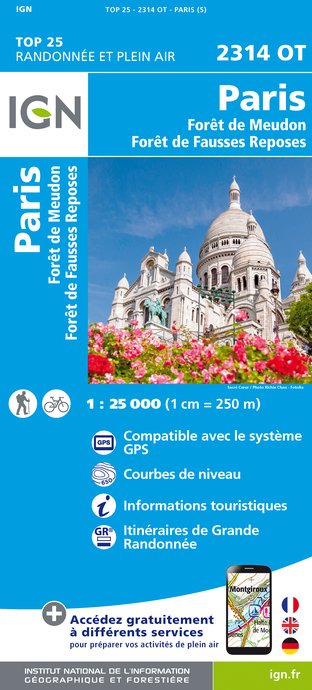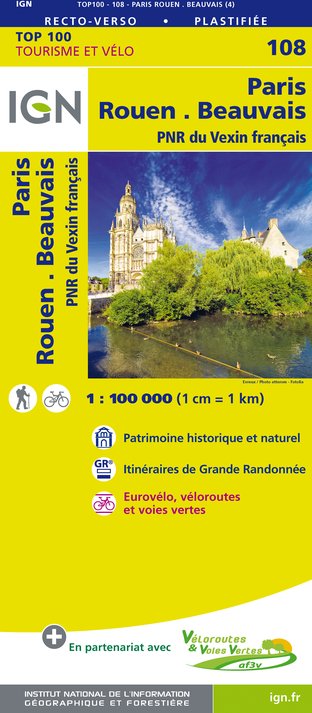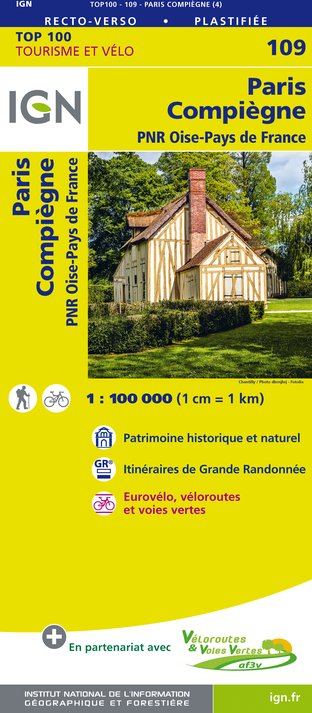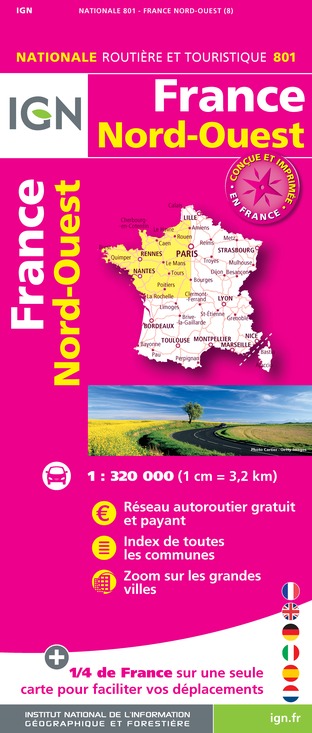Allarme
Allarmi
Tipo di pratica
A piedi
In bicicletta
Presentazione
Mappa
Punti di interesse
Sintesi di Cirkwi
Valutazioni e recensioni
Vedi nei dintorni
Esposizione Universale del 1878


Credito : Musée carnavalet
Il breve di Cirkwi
Scopri il cuore di Parigi: un viaggio attraverso l'Esposizione Universale del 1878
Seguendo le orme dell'Esposizione Universale del 1878, questo affascinante viaggio ti invita a esplorare la Parigi storica e Courbevoie, presentata dalla mente creativa di Balades Fluviales Fabienne Lemoine Fondateur. Immergiti in una narrazione che risale a un evento cruciale della storia parigina, dove innovazione e bellezza si sono incontrate su una scala senza precedenti. Avventurati in una passeggiata rilassante tra i luoghi simbolo che fanno eco alla grandiosità del passato, vivendo l'essenza di Parigi accanto ai frammenti che hanno resistito alla prova del tempo. Questa avventura promette più di un semplice tour; è un portale verso il passato, meticolosamente curato per i curiosi e i sognatori.
Informazioni tecniche sull'itinerario essenziale
Questo itinerario copre una distanza totale di circa 10,78 km, con un dislivello che ti porterà da 24 metri nel punto più basso a 65 metri nel punto più alto. Affronterai un percorso dolcemente ondulato, con una variazione altimetrica positiva compresa tra 153 e 143 metri. Il percorso designato è principalmente a misura di pedone, rendendolo un percorso ideale per coloro che amano passeggiare. Perfettamente adatto per l'esplorazione di una giornata, offre un'avventura accessibile per partecipanti di diversi livelli di forma fisica, offrendo una combinazione di viste panoramiche e conoscenza storica.
Consigli stagionali per gli esploratori
Per massimizzare la tua esperienza, è importante vestirsi adeguatamente in base all'occasione e alla stagione. Le primavere e gli autunni di Parigi offrono temperature miti ideali per lunghe passeggiate, mentre il calore dell'estate permette un ritmo più tranquillo con molte pause all'ombra. L'inverno, sebbene più freddo, ha comunque il suo fascino con meno affluenza: basta assicurarsi di indossare strati di abbigliamento. Indipendentemente dalla stagione, le scarpe comode da passeggio sono un must. Per quanto riguarda la sicurezza, rimani sempre consapevole dell'ambiente circostante, soprattutto nelle zone affollate della città. Porta con te acqua, magari uno spuntino, e lascia che le condizioni meteorologiche della giornata guidino la tua preparazione - crema solare per le giornate di sole, impermeabile per le imprevedibili piogge parigine.
Parigi e Courbevoie: un ricco arazzo
Questo viaggio ti porta nel cuore di Parigi, una città sinonimo di profondità storiche e grandezza architettonica, e si estende a Courbevoie, svelando strati diversi del patrimonio della regione della capitale francese. Parigi, con il suo layout compatto, comprende siti monumentali che hanno ospitato significativi dialoghi globali, come le grandi esposizioni. Courbevoie, spesso eclissata, svolge un ruolo vitale come satellite storico e culturale della metropoli. Questa regione, che racchiude l'essenza dei successi umani e dell'espressione artistica, è un testimonianza della resilienza e dell'ingegno dell'animo umano mostrati durante l'Esposizione Universale del 1878.
Informazioni sul meteo: pianifica la tua visita
Il clima a Parigi può essere ampiamente classificato come temperato, con stagioni distinte che offrono esperienze variegate. Gli inverni sono freddi con occasionali gelate, mentre le estati possono essere calde e talvolta umide. La primavera e l'autunno offrono il clima più piacevole, caratterizzato da temperature miti e brezze leggere - ideale per i tour a piedi. Date queste condizioni climatiche, i periodi ideali per intraprendere questo viaggio storico sono la tarda primavera (maggio-giugno) e l'inizio dell'autunno (settembre-ottobre), quando le condizioni meteorologiche si sposano perfettamente con le esplorazioni all'aperto, garantendo un'esperienza confortevole e arricchente.
Seguendo le orme dell'Esposizione Universale del 1878, questo affascinante viaggio ti invita a esplorare la Parigi storica e Courbevoie, presentata dalla mente creativa di Balades Fluviales Fabienne Lemoine Fondateur. Immergiti in una narrazione che risale a un evento cruciale della storia parigina, dove innovazione e bellezza si sono incontrate su una scala senza precedenti. Avventurati in una passeggiata rilassante tra i luoghi simbolo che fanno eco alla grandiosità del passato, vivendo l'essenza di Parigi accanto ai frammenti che hanno resistito alla prova del tempo. Questa avventura promette più di un semplice tour; è un portale verso il passato, meticolosamente curato per i curiosi e i sognatori.
Informazioni tecniche sull'itinerario essenziale
Questo itinerario copre una distanza totale di circa 10,78 km, con un dislivello che ti porterà da 24 metri nel punto più basso a 65 metri nel punto più alto. Affronterai un percorso dolcemente ondulato, con una variazione altimetrica positiva compresa tra 153 e 143 metri. Il percorso designato è principalmente a misura di pedone, rendendolo un percorso ideale per coloro che amano passeggiare. Perfettamente adatto per l'esplorazione di una giornata, offre un'avventura accessibile per partecipanti di diversi livelli di forma fisica, offrendo una combinazione di viste panoramiche e conoscenza storica.
Consigli stagionali per gli esploratori
Per massimizzare la tua esperienza, è importante vestirsi adeguatamente in base all'occasione e alla stagione. Le primavere e gli autunni di Parigi offrono temperature miti ideali per lunghe passeggiate, mentre il calore dell'estate permette un ritmo più tranquillo con molte pause all'ombra. L'inverno, sebbene più freddo, ha comunque il suo fascino con meno affluenza: basta assicurarsi di indossare strati di abbigliamento. Indipendentemente dalla stagione, le scarpe comode da passeggio sono un must. Per quanto riguarda la sicurezza, rimani sempre consapevole dell'ambiente circostante, soprattutto nelle zone affollate della città. Porta con te acqua, magari uno spuntino, e lascia che le condizioni meteorologiche della giornata guidino la tua preparazione - crema solare per le giornate di sole, impermeabile per le imprevedibili piogge parigine.
Parigi e Courbevoie: un ricco arazzo
Questo viaggio ti porta nel cuore di Parigi, una città sinonimo di profondità storiche e grandezza architettonica, e si estende a Courbevoie, svelando strati diversi del patrimonio della regione della capitale francese. Parigi, con il suo layout compatto, comprende siti monumentali che hanno ospitato significativi dialoghi globali, come le grandi esposizioni. Courbevoie, spesso eclissata, svolge un ruolo vitale come satellite storico e culturale della metropoli. Questa regione, che racchiude l'essenza dei successi umani e dell'espressione artistica, è un testimonianza della resilienza e dell'ingegno dell'animo umano mostrati durante l'Esposizione Universale del 1878.
Informazioni sul meteo: pianifica la tua visita
Il clima a Parigi può essere ampiamente classificato come temperato, con stagioni distinte che offrono esperienze variegate. Gli inverni sono freddi con occasionali gelate, mentre le estati possono essere calde e talvolta umide. La primavera e l'autunno offrono il clima più piacevole, caratterizzato da temperature miti e brezze leggere - ideale per i tour a piedi. Date queste condizioni climatiche, i periodi ideali per intraprendere questo viaggio storico sono la tarda primavera (maggio-giugno) e l'inizio dell'autunno (settembre-ottobre), quando le condizioni meteorologiche si sposano perfettamente con le esplorazioni all'aperto, garantendo un'esperienza confortevole e arricchente.
Generato automaticamente.
IGN Carte

2314OT - PARIS FORÊT DE MEUDON FORÊT DE FAUSSES REPOSES
Editore : IGN
Collezione : TOP 25 ET SÉRIE BLEUE
Scala : 1:25 000
13.90€

190 PARIS CHANTILLY FONTAINEBLEAU
Editore : IGN
Collezione : TOP 100
Scala : 1:100 000
8.40€

118 PARIS CHARTRES PNR DE LA HAUTE VALLÉE DE CHEVREUSE
Editore : IGN
Collezione : TOP 100
Scala : 1:100 000
8.40€

108 PARIS ROUEN BEAUVAIS PNR DU VEXIN FRANÇAIS
Editore : IGN
Collezione : TOP 100
Scala : 1:100 000
8.40€

109 PARIS COMPIÈGNE PNR OISE-PAYS DE FRANCE
Editore : IGN
Collezione : TOP 100
Scala : 1:100 000
8.40€

D75-95 ÎLE-DE-FRANCE OUEST
Editore : IGN
Collezione : CARTES DÉPARTEMENTALES IGN
Scala : 1:150 000
5.90€

D77 SEINE-ET-MARNE
Editore : IGN
Collezione : CARTES DÉPARTEMENTALES IGN
Scala : 1:150 000
5.90€

D28 EURE-ET-LOIR
Editore : IGN
Collezione : CARTES DÉPARTEMENTALES IGN
Scala : 1:150 000
5.90€

NR01 HAUTS-DE-FRANCE
Editore : IGN
Collezione : CARTES RÉGIONALES IGN
Scala : 1:250 000
6.80€

NR08 CENTRE-VAL DE LOIRE
Editore : IGN
Collezione : CARTES RÉGIONALES IGN
Scala : 1:250 000
6.80€

NR03 ÍLE DE FRANCE
Editore : IGN
Collezione : CARTES RÉGIONALES IGN
Scala : 1:250 000
6.80€

801 FRANCE NORD OUEST
Editore : IGN
Collezione : CARTES NATIONALES IGN
Scala : 1:320 000
6.10€

EUROPE
Editore : IGN
Collezione : DÉCOUVERTE DES PAYS DU MONDE IGN
Scala : 1:2 500 000
7.00€
Informazioni tecniche
A piedi
Difficoltà
Non specificata
Dist.
11 km
Tipo di pratica
A piedi
In bicicletta
Mostra di più
Profilo altimetrico
Punto di partenza
75007
Paris
Lat : 48.86047Lng : 2.32498
Punti di interesse
Autore dei dati
Valutazioni e recensioni
Da vedere nei dintorni







